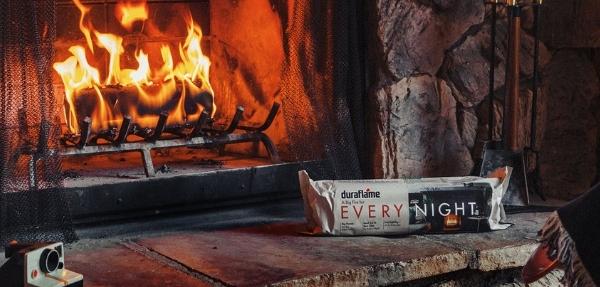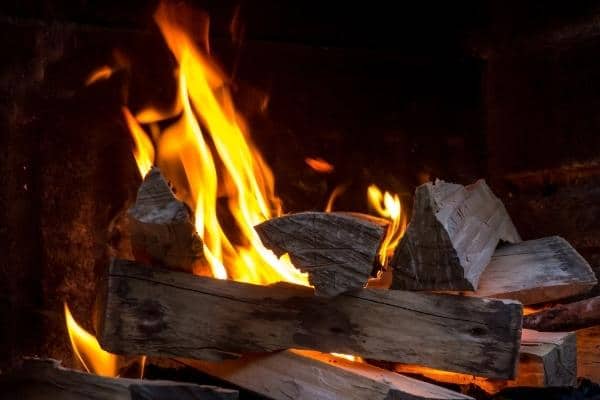If you have a fireplace or fire pit, you want to make the most informed decisions about what to burn in it. Traditionally, of course, only one thing was burned in them: wood.
But these days, there are actually many options for what to burn in or around your home. This includes both traditional wood and many choices of firelogs with varying characteristics and quality.
So, if you are trying to decide between firewood or firelogs, know that there are benefits and drawbacks to using both. Read on to know the difference and see a head-to-head comparison between the two.
Firelogs Vs. Wood: Are Firelogs Better Than Wood?
These days, there are lots of options for firelogs. But before getting into that, it’s important to begin with a fundamental question: are firelogs better than wood?
Generally, firelogs are better than wood in the sense that they are more environmentally friendly, leave less mess behind, and burn longer. However, wood beats artificial firelogs when it comes to producing heat and ambiance.
Firewood burns nearly four times hotter than firelogs and can be used anywhere, making them the better choice if used as a primary heat source. Firelogs are more limited. More on that later.
In practice, the answer depends on your preferences and the type of fireplace you have. For some people, nothing can beat the sound, smell, and general experience of burning real wood. For others, the convenience and comfort of a firelog do the job.
Are Firelogs Real Wood?
If you are unfamiliar with firelogs, your first question may simply be: are firelogs real wood? The short answer is no.
Firelogs are produced from recycled materials, including sawdust, cellulose, and waxes. The sawdust is generally byproduct, or waste, from a lumber mill that is repurposed. Some firelogs use other industrial byproducts or recycled materials, including coffee grinds and coconut husks.
While they may have wood-derived products, they are not wood but are instead more akin to candles.
What Are the Benefits of Firelogs?

Why even bother burning “artificial” logs? Is it not better to just burn real wood?
In fact, there are a few reasons why firelogs might be a good choice for you.
Ease of Use
The principal appeal of firelogs is that they are convenient. Anyone who has spent time building a fire knows that the process can sometimes be tricky.
As a general rule of thumb, the process requires tinder (like paper, birch bark, wood shavings, or something similar), kindling (generally small pieces of wood or bark), and ultimately fuel, meaning bigger logs.
If you buy cordwood—another name for firewood—you may also have to buy supplies of kindling and tinder and make sure you always have enough of each in your home. If you split your own wood, you’ll need to make sure you collect or split enough kindling as well.
Even then, the process isn’t always easy. Sometimes wood gets wet, making it trickier to light. Plus, fires can sometimes just be challenging to start for other reasons: a bad draft, cold wood, and sometimes just bad luck! Navigating this process when you just want to start a nice fire can be a real pain.
With firelogs, you can forget about all that. Firelogs are almost universally easy to start — most simply require lighting the wrapper they come in at a designated point.
Environmental Impact
According to some, burning firelogs is more environmentally friendly than burning cordwood. According to one study done by the EPA and Environment Canada, the combustion of firelogs produces considerably less carbon monoxide and other emissions. Plus, no trees need to be cut down to burn firelogs.
Of course, the comparison is a little difficult to make because cordwood and firelogs are traditionally used for different purposes. (E.g. firelogs are not used for home heating.) Plus, the byproducts used in firelogs may derive from environmentally unfriendly processes that can be difficult to quantify.
Range of Choice
Another great benefit of firelogs is choice. To put it simply: there are many options out there.
This article offers a helpful comparison of firelogs, grading them on categories like burn time, warmth, and overall ambiance.
With firelogs, you can choose a slow-burning log, a faster-burning one, one made from different ingredients, and more.
What Are the Benefits of Cordwood?
For thousands of years, people have burned real wood for fires. Firelogs are, after all, a relatively new innovation, and some advantages just cannot be beaten when compared with cordwood.
Heat
When considering firelogs vs. cordwood, one big question is whether heat is a primary objective. The truth is, real wood simply cannot be outdone when it comes to heat production.
While there is some variation in heat produced between various brands of firelogs — outlined in the article above — there are no artificial logs that compare to wood in terms of heat emitted.
In short — if you’re looking for a nice burn to watch while you hang around the fireplace, a firelog may be just fine. But if you’re really looking to warm up a room or heat your home, you will need to use cordwood.
Where Can You Use It?
Another essential detail to consider is where you will burn your firewood or firelogs.
Some sites — an outdoor fire pit or an open fireplace — can easily accommodate both types of fuel. But others cannot. You have to burn cordwood if you have a wood stove or an enclosed wood fireplace. Firelogs do not work in these types of enclosed spaces.
Can You Roast Marshmallows Over a Duraflame Log?
Of course, maybe your aim is simply a time-honored one: roasting marshmallows. If it is, know that it is perfectly safe to roast marshmallows over some types of Duraflame logs. According to Duraflame, their outdoor firelogs are safe for roasting marshmallows.
While most firelogs are not toxic and may be safe for roasting marshmallows, it is important to check the packaging and/or reach out to the manufacturer to determine if burning a marshmallow is safe. Many firelogs advise against it, but there are some specific ones that advertise they are suited for this.
It is also worth noting that the limited heat many firelogs produce — and in some, the relatively limited flame — might make cooking up s’mores a little tougher.
Aesthetics of Burning Wood
There is one area in which firelogs inevitably come up short: the feel of a real fire. The fact is, firelogs simply cannot provide a real substitute for the cracking, hissing — and, as previously mentioned, heat — that comes from burning real wood for a fire.
This may not matter much to you, but you will have to go with cordwood if this is part of the experience you’re after.
Which Type of Log Burns Longer?
This is a tricky question because the answer in practice depends on your reason for use. The short version is that an individual firelog will likely burn longer than an individual real log. Accordingly, if you just want to sit in front of the fireplace and enjoy the visual of a slow burn, firelogs might be right for you.
However, in practice, the answer is a little more complicated. Building a fire from real wood takes time to get going. But once it’s hot, it will produce its bed of coals, casting the warm, familiar glow of a fire and allowing you to keep adding logs — generally with relative ease — until you decide to let the fire die down or put it out.
With firelogs, you tend to light one log and let it burn itself out. But with real wood, you tend to stoke the fire and add more logs. So it’s really a matter of preference: sit back and let it go or add a real log here and there to keep the fire going longer? You have to decide what you’re in the mood for.
Is It Better To Burn Wood or Duraflame?
Based on the information above, it is ultimately up to you to make the best choice for your home. To start, take into account the different benefits of each, asking yourself relevant questions, such as:
- Are you burning wood for heat?
- Are you burning wood for ambiance?
- Where are you burning wood — a wood stove, a fireplace, or someplace else?
- Does the smell and “feel” of a fire matter to you?
- Do you like the maintenance involved in building a fire, or would you rather simply light a log and let it go?
These questions can generally help you make an informed decision. Of course, some of them are rigid — for instance, if you have a wood stove and want a fire, you will have to burn real wood. But others are more nuanced.
If you are looking for easy ambiance and no hassle, a firelog may be right for you. This may be particularly true if you want to minimize your environmental impact as much as possible, and you can heat your home from sources other than wood.
On the other hand, if it is a cold winter’s night and you have a draft in your home, building a nice real fire out of cordwood may make more sense.
Remember, there’s no right or wrong answer. Sometimes burning cordwood is the best choice, and other times burning firelogs makes more sense. Think about your needs, experiment with different options, and you will find a suitable solution for your home!






